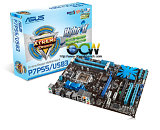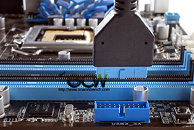- Joined
- Oct 9, 2007
- Messages
- 47,775 (7.41/day)
- Location
- Dublin, Ireland
| System Name | RBMK-1000 |
|---|---|
| Processor | AMD Ryzen 7 5700G |
| Motherboard | Gigabyte B550 AORUS Elite V2 |
| Cooling | DeepCool Gammax L240 V2 |
| Memory | 2x 16GB DDR4-3200 |
| Video Card(s) | Galax RTX 4070 Ti EX |
| Storage | Samsung 990 1TB |
| Display(s) | BenQ 1440p 60 Hz 27-inch |
| Case | Corsair Carbide 100R |
| Audio Device(s) | ASUS SupremeFX S1220A |
| Power Supply | Cooler Master MWE Gold 650W |
| Mouse | ASUS ROG Strix Impact |
| Keyboard | Gamdias Hermes E2 |
| Software | Windows 11 Pro |
With a small but sizable, and growing number of PC cases with front-panel USB 3.0 ports, it is making sense for motherboard vendors to reciprocate with motherboards that have USB 3.0 front-panel headers. Spearheading this is ASUS, with its new mainstream socket LGA1156 motherboard based on the Intel P55 chipset, the P7P55/USB3. USB 3.0 has a different front-panel header layout from USB 2.0/1.1, and on ASUS' motherboard, there are two NEC-made 2-port USB 3.0 controllers, one for the two rear USB 3.0 ports, and one for the 2-port USB 3.0 header. The header can connect to front-panel ports, or simply provide two rear ports using an expansion bracket.
Apart from that, the P7P55/USB3 is a fairly standard offering with 4+2 phase CPU VRM, one PCI-Express 2.0 x16 slot, a PCI-Express x16 (electrical x4) slot, and two each of PCI-E x1 and PCI. The P55 PCH provides six SATA 3 Gb/s ports, connectivity features include 8-channel HD audio with optical SPDIF output, gigabit Ethernet, and USB 3.0. ASUS did not give out a price, though one can expect this model to be on the lower side, we expect under $150.


View at TechPowerUp Main Site
Apart from that, the P7P55/USB3 is a fairly standard offering with 4+2 phase CPU VRM, one PCI-Express 2.0 x16 slot, a PCI-Express x16 (electrical x4) slot, and two each of PCI-E x1 and PCI. The P55 PCH provides six SATA 3 Gb/s ports, connectivity features include 8-channel HD audio with optical SPDIF output, gigabit Ethernet, and USB 3.0. ASUS did not give out a price, though one can expect this model to be on the lower side, we expect under $150.


View at TechPowerUp Main Site



 - So here's the stills...
- So here's the stills...



